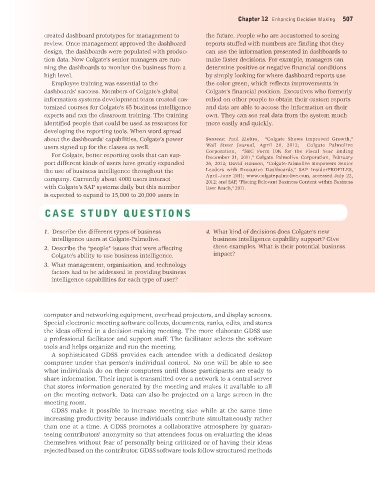Page 508 -
P. 508
Chapter 12 Enhancing Decision Making 507
created dashboard prototypes for management to the future. People who are accustomed to seeing
review. Once management approved the dashboard reports stuffed with numbers are finding that they
design, the dashboards were populated with produc- can use the information presented in dashboards to
tion data. Now Colgate’s senior managers are run- make faster decisions. For example, managers can
ning the dashboards to monitor the business from a determine positive or negative financial conditions
high level. by simply looking for where dashboard reports use
Employee training was essential to the the color green, which reflects improvements in
dashboards’ success. Members of Colgate’s global Colgate’s financial position. Executives who formerly
information systems development team created cus- relied on other people to obtain their custom reports
tomized courses for Colgate’s 65 business intelligence and data are able to access the information on their
experts and ran the classroom training. The training own. They can see real data from the system much
identified people that could be used as resources for more easily and quickly.
developing the reporting tools. When word spread
about the dashboards’ capabilities, Colgate’s power Sources: Paul Ziobro, “Colgate Shows Improved Growth,”
users signed up for the classes as well. Wall Street Journal, April 26, 2012; Colgate Palmolive
Corporation, “SEC Form 10K for the Fiscal Year Ending
For Colgate, better reporting tools that can sup- December 31, 2011,” Colgate Palmolive Corporation, February
port different kinds of users have greatly expanded 26, 2012; David Hannon, “Colgate-Palmolive Empowers Senior
the use of business intelligence throughout the Leaders with Executive Dashboards,” SAP InsiderPROFILES,
April–June 2011; www.colgatepalmolive.com, accessed July 22,
company. Currently about 4000 users interact
2012; and SAP, “Placing Relevant Business Content within Business
with Colgate’s SAP systems daily but this number User Reach,” 2011.
is expected to expand to 15,000 to 20,000 users in
CASE STUDY QUESTIONS
1. Describe the different types of business 4. What kind of decisions does Colgate’s new
intelligence users at Colgate-Palmolive. business intelligence capability support? Give
2. Describe the “people” issues that were affecting three examples. What is their potential business
Colgate’s ability to use business intelligence. impact?
3. What management, organization, and technology
factors had to be addressed in providing business
intelligence capabilities for each type of user?
computer and networking equipment, overhead projectors, and display screens.
Special electronic meeting software collects, documents, ranks, edits, and stores
the ideas offered in a decision-making meeting. The more elaborate GDSS use
a professional facilitator and support staff. The facilitator selects the software
tools and helps organize and run the meeting.
A sophisticated GDSS provides each attendee with a dedicated desktop
computer under that person’s individual control. No one will be able to see
what individuals do on their computers until those participants are ready to
share information. Their input is transmitted over a network to a central server
that stores information generated by the meeting and makes it available to all
on the meeting network. Data can also be projected on a large screen in the
meeting room.
GDSS make it possible to increase meeting size while at the same time
increasing productivity because individuals contribute simultaneously rather
than one at a time. A GDSS promotes a collaborative atmosphere by guaran-
teeing contributors’ anonymity so that attendees focus on evaluating the ideas
themselves without fear of personally being criticized or of having their ideas
rejected based on the contributor. GDSS software tools follow structured methods
MIS_13_Ch_12 global.indd 507 1/17/2013 2:30:35 PM

